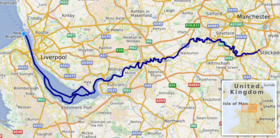Mersey Barrage
| Mersey Barrage | |
|---|---|
 The Mersey waterfront at Liverpool | |
 The River Mersey is highlighted in blue interactive map Coordinates: 53°27′00″N 3°01′59″W / 53.45°N 3.033°W |

The Mersey Barrage is a proposed scheme for building a tidal barrage across the Mersey Estuary, between Liverpool and the Wirral Peninsula, England.
History
[edit]The River Mersey is considered to be a suitable source of marine renewable energy in the United Kingdom, because of its strong current and tidal range of up to 10 m (33 ft),[1][2] the second highest in the United Kingdom.[3]
A Department of the Environment and UKAEA report in 1984 identified a site between New Brighton and Brocklebank Dock for a Mersey barrage.[4]
A 2006 study by Peel Holdings and the North West Development Agency identified the River Mersey as having considerable potential for tidal power. A pilot project, using a water wheel to harness tidal power, was considered at Bootle docks.[5] At the same time, a tidal barrage plan was evaluated, capable of generating 700 MW.[6]
A barrage scheme was abandoned in 2011, following a study by Peel Energy and the North West Development Agency. This proposal involved constructing a barrage between Dingle on the Liverpool bank and New Ferry on the Wirral bank. Although the study provided valuable insight, the preferred scheme was abandoned due to the expected lack of medium-term profitability.[7]
Steve Rotheram revived plans for a barrage as part of his 2017 election campaign.[8] The 2018 study indicated that economics were more favourable than previously, but still fell short by 20%.[9] In February 2020, following a year-long feasibility study, a tidal power proposal for the River Mersey was granted £2.5 million in funding to further develop the plan.[3][10] In December 2022, the Liverpool City Region mayor announced an agreement between the City Region and K-water of South Korea, who built and operates the Sihwa Lake Tidal Power Station, to carry out "reciprocal visits and information sharing".[11][12] The Mersey Tidal Power Project was launched as "a scoping project" in March 2024.[13] The projected power output is not stated but it is suggested that the scheme will be able to "power a million homes".
The tidal barrage plan was put to public consultation in September 2024, starting the formal planning process.[14]
Economic impact
[edit]A Mersey barrage has been predicted to be capable of producing between 1.0 and 1.5 terawatt-hours of electricity per year (0.11 to 0.17 GW), which is equivalent to two-thirds of Liverpool's 2017 electricity requirement.[15]
One design has proposed that cross-river public transport infrastructure is included in the construction.[16]
Environmental impact
[edit]The estuary is designated as an internationally important protected area, for wading birds, ducks and fish. The Lancashire Wildlife Trust and the Cheshire Wildlife Trust are monitoring the progress of the proposals, and the potential impact on existing habitat and wildlife within the estuary.[9][17] Following a similar scheme with the Rance Tidal Power Station in Brittany, some marine fauna initially suffered, but a new equilibrium was achieved after ten years.[18]
See also
[edit]- Cardiff Bay Barrage
- Centre Port
- Hydroelectricity in the United Kingdom
- List of tidal power stations
- Marine current power
- Marine energy
- Run-of-the-river hydroelectricity
- Severn Barrage
- Tidal power
References
[edit]- ^ "Water way to power up area is considered". Cheshire Live. 21 December 2006. Retrieved 4 April 2021.
- ^ "Mersey wheel offers power". Planning Resource. 22 June 2007. Retrieved 4 April 2021.
- ^ a b McDonough, Tony (6 October 2020). "Mersey can provide 100 years of clean energy". LBN Daily. Retrieved 4 April 2021.
- ^ "Tapping the Tidal Power Potential of the Eastern Irish Sea" (PDF). Centre for Offshore Renewable Energy Research. March 2009. pp. 51, 194 (per pdf). Retrieved 4 April 2021.
- ^ "Mersey ideal for renewable energy". BBC News. 12 December 2006. Retrieved 4 April 2021.
- ^ "Power from the Mersey". The Engineer. 15 June 2007. Retrieved 4 April 2021.
- ^ "Mersey Estuary tidal power scheme 'will not go ahead'". BBC News. 22 June 2011. Retrieved 4 April 2021.
- ^ "Mayor Steve Rotheram revives River Mersey tidal power plan". BBC News. 14 November 2017. Retrieved 4 April 2021.
- ^ a b "Mersey tidal energy". Lancashire Wildlife Trust. Retrieved 4 April 2021.
- ^ "River Mersey tidal power plan granted £2.5m funding". BBC News. 28 February 2020. Retrieved 4 April 2021.
- ^ "Plans for huge barrage across River Mersey progress after new agreement". 6 December 2022.
- ^ "Mersey tidal power: Agreement signed with South Korean giant". BBC News. 6 December 2022.
- ^ "Mersey Tidal Power". Liverpool City Region. Retrieved 12 March 2024.
- ^ Smith, Mark (21 September 2024). "Public views sought over Mersey tidal barrier plan". BBC News. Retrieved 28 September 2024.
- ^ "The Energy River: Realising Energy Potential from the River Mersey" (PDF). University of Liverpool. June 2017. p. 5. Retrieved 4 April 2021.
- ^ "Mersey Barrage – Infrastructure Design". Buju. Retrieved 4 April 2021.
- ^ "Mersey barrage scheme". Cheshire Wildlife Trust. Retrieved 4 April 2021.
- ^ "Liverpool: huge tidal power plant on the Mersey could make city a renewable energy hotspot". The Conversation. 1 August 2019. Retrieved 4 April 2021.

